ERWIN, Tenn. — As Hurricane Helene dumped record levels of rain on East Tennessee, the swollen Nolichucky River overtook a small plastics factory and the only road out. A panicked group of workers, who had climbed aboard a truck’s trailer in front of the plant, were swept away by the raging floodwater.
In the days after the Sept. 27 flood, the bodies of five of the Impact Plastics Inc. employees were found: Sibrina Barnett, 53; Monica Hernandez-Corona, 44; Bertha Mendoza, 56; Johnny Peterson, 55; and Lidia Verdugo Gastelum, 63. The search continues for a sixth employee, Rosa Maria Andrade Reynosa, 29. Five employees on the trailer survived.
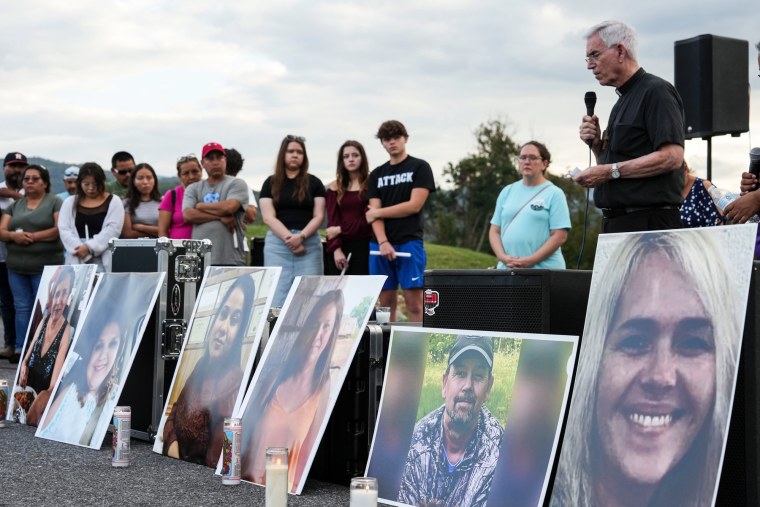 Rev. Tom Charters, speaks during a vigil for the Erwin, Tenn. flood victims on Oct. 3. From right, are portraits of Sibrina Barnett, Johnny Peterson, Lydia Verdugo, Rosa Maria Adrade Reynoso, Monica Hernandez Corona, and Bertha Mendoza.Saul Young / The Knoxville News-Sentinel via USA Today Network
Rev. Tom Charters, speaks during a vigil for the Erwin, Tenn. flood victims on Oct. 3. From right, are portraits of Sibrina Barnett, Johnny Peterson, Lydia Verdugo, Rosa Maria Adrade Reynoso, Monica Hernandez Corona, and Bertha Mendoza.Saul Young / The Knoxville News-Sentinel via USA Today NetworkMichael Dorsey, the driver, said he and the others clung to cargo in the step-deck trailer — a split-level open bed that attaches to a semi-truck cab — as the water rose. But debris hit the trailer several times and it capsized, sending them into the fast-moving river, according to Impact Plastics and Dorsey.
The tragedy shook Erwin, a working-class mountain town in Appalachia of about 6,000. Some relatives and community members described lackluster efforts to find their loved ones. And frustration peaked when a state official — pressed by the mostly Latino relatives of the missing employees — said he was unaware of the town’s Latino community. Mostly, families wanted answers to a critical question: How could this happen?
Now, an NBC News investigation based on interviews with survivors, messages between families and victims, National Weather Service alerts and data, company statements and other material reveals how events unfolded on the day a workplace in the Tennessee mountains became the deadly focal point of a one-in-5,000-year flood.
It’s also a window into what can happen when communities are faced with never-before-seen weather events brought on by climate change. Workplaces and localities are left to consider whether the changed weather landscape demands that they plan for what was thought to be unimaginable.
Conflicting narratives have emerged about what happened that day. Workers have told NBC News they were anxious about the impending hurricane-related weather when their shift began and that their worry grew as weather service alerts and notifications pinged on their phones.
“I just wish we never went to work that day,” said Impact Plastics employee Robert “Robby” Jarvis. “Because it was unnecessary. All these lives we lost because of that. It was wrong.”
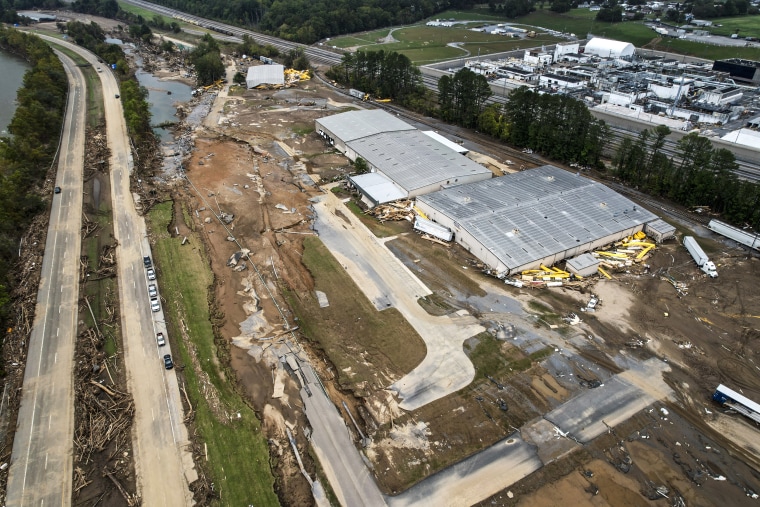 Damage caused by flooding from Hurricane Helene around Impact Plastics on Oct. 4.Jeff Roberson / AP file
Damage caused by flooding from Hurricane Helene around Impact Plastics on Oct. 4.Jeff Roberson / AP fileImpact Plastics owner Gerald O’Connor said in a video statement that “we are heartbroken” over the losses, which he said included a longtime friend. “The findings are that employees were told to leave the plant at least 45 minutes before the gigantic force of the flood hit the industrial park. There was time to escape," he said.
Along with the video, the company issued written statements, including the results of a preliminary review that stated it had an evacuation plan for emergencies posted at the plant long before Sept. 27. Employees have said there wasn’t any kind of plan in the event of a flood.
The Tennessee Bureau of Investigation and Tennessee Occupational Health and Safety Administration have launched investigations into the circumstances around the deaths of the Impact Plastics employees. O’Connor has declined interview requests and further comment while the investigations are ongoing.
Impact Plastics employees and relatives of those who died are also grappling with why first responders did not get to their loved ones before the floodwaters engulfed them. Several of the victims made final calls to relatives more than an hour and a half after leaving their company’s flooded parking lot.
A mile and a half from the plastics plant, about five dozen people were airlifted from the roof of Unicoi County Hospital downriver in a dangerous multiagency rescue operation.
The hurricane's lashing of the Appalachian region was so unexpected that it was difficult to do anything in advance, officials said. “It’s hard to imagine preparation for something that’s never happened,” Gov. Bill Lee said at a news conference.
Hurricane Helene twisted through six states, leaving more than 200 dead and dozens missing. It made landfall in Florida on Sept. 26, a Thursday.
The day before, the National Weather Service in Morristown, Tennessee, issued several warnings of potential flooding the rest of the week. One forecast read: “An extreme risk of life-threatening flooding exists near the TN/NC state line into western North Carolina.”
Impact Plastics is in a Federal Emergency Management Agency designated flood zone, but employees and managers said they had never seen flooding like this at the plant.
The Unicoi school district canceled school for Sept. 26 and 27, Thursday and Friday, citing weather warnings. Foam Products Corp., in the same industrial park as Impact Plastics, closed their doors Thursday and Friday as well, according to the general manager, Perry Muse. It was the first time their Erwin plant had ever closed for extreme weather.
Impact Plastics, which manufactures components for cars, helicopters, furniture and other products, decided to open that Friday; so did other nearby businesses.
The following is a timeline of the events at the Impact Plastics plant during Hurricane Helene:
Friday, Sept. 27
7 a.m.
The day’s early shift began “as usual,” according to Impact Plastics in an Oct. 3 statement, adding that “there had been no flood alert or warning” at this point. This is despite the NWS warnings and school closings.
8:30 a.m.- 8:45 a.m.
An Impact Plastics worker, who did not want his name used for fear of retaliation from the company, started to see news on his phone of flooding in the area. Another Impact Plastics employee, Zinnia Adkins, started to get “messages, alerts” on her phone urging evacuation, she said. Fearful of water, she called her husband at 8:42 a.m., according to her call logs. She estimated about 25 to 30 employees were at the plant that day.
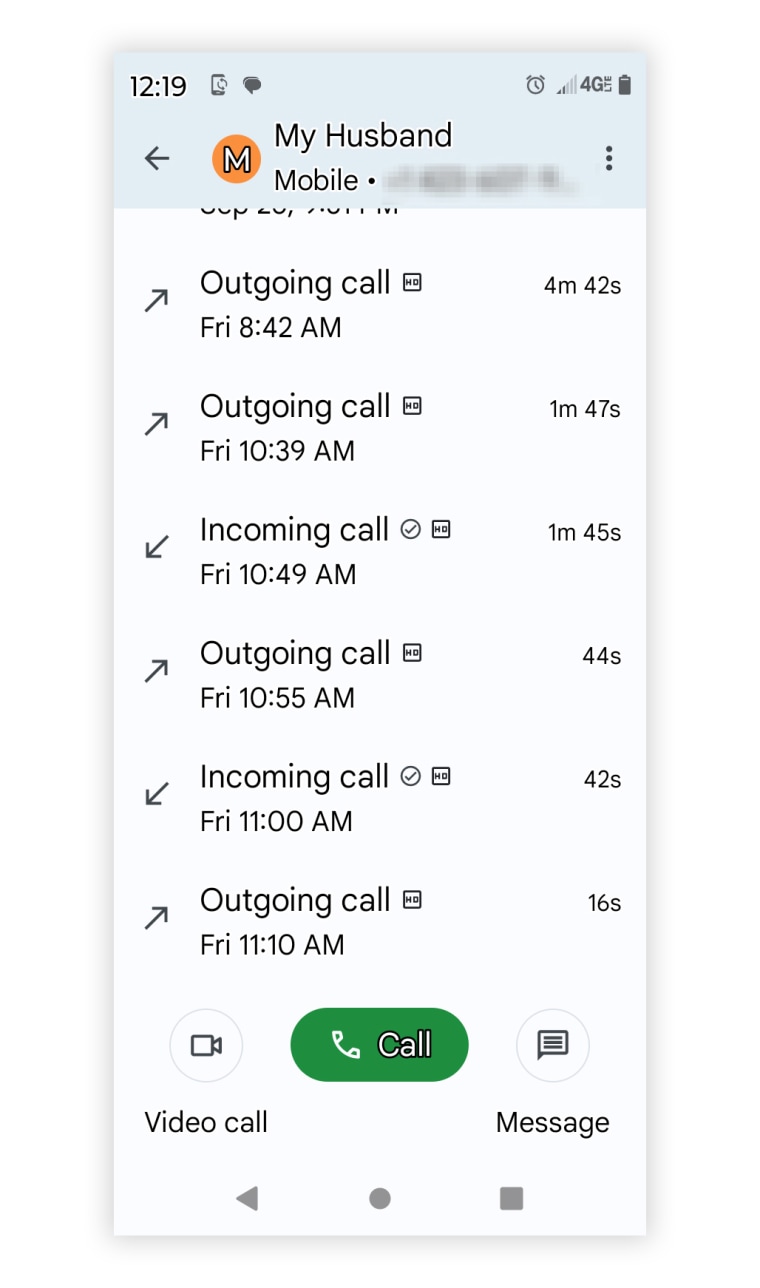 A screenshot of Zinnia Adkins' cell phone shows she called her husband at 8:42 a.m. on Sept. 27.Zinnia Adkins
A screenshot of Zinnia Adkins' cell phone shows she called her husband at 8:42 a.m. on Sept. 27.Zinnia Adkins9 a.m.
Erick Castellón, an employee at Old Hickory Buildings, a storage shed builder less than a mile upriver from Impact Plastics, is dismissed for the day via a message from his boss telling all workers to leave, he said.
9:14 a.m.
The NWS sent its first wireless emergency alert in Erwin. The warning appeared as pop-up messages on phones receiving service from cell towers in the at-risk area. For phones with 4G service and above, it would have read: “A FLASH FLOOD WARNING is in effect for this area until 12:00 PM EDT. This is a dangerous and life-threatening situation. Do not attempt to travel unless you are fleeing an area subject to flooding or under an evacuation order.” Unicoi County Emergency Manager Jimmy Erwin told NBC News there had been no indication that cell phone towers were down that morning. Televisions and radios in the area would have received longer warnings.
Impact Plastics employee Jackie Rangek was eating breakfast and noticed alerts on her phone around this time, she said. They frightened her and she consulted a co-worker, but neither knew what to do, so they returned to work.
9:20 a.m.
The NWS sent another emergency alert to phones in the area, upgrading its “flash flood warning” to “flash flood emergency.” A “flash flood emergency” is a higher level alert issued for “exceedingly rare” situations when heavy rain is leading to a severe threat to human life resulting in rescues and evacuations and “catastrophic damage” is happening or will happen soon.
10 a.m.
Rangek recalled seeing another alert on her phone, but Impact Plastics employees continued working, she said. “We didn’t do anything then, again, because they didn’t tell us anything the first time,” Rangkek said in Spanish.
10:30 a.m.
As businesses begin to lose power, workers in a warehouse next to the Nolichucky River are moved by their employer, Nuclear Fuel Services, a fuel material manufacturer, to the company’s nearby main property that is at a higher elevation, according to an emailed statement from Chris Dumond, the parent company’s spokesman.
10:35 a.m.
Water began to pool in the Impact Plastics parking lot, according to the company's publicly released preliminary review, which also stated the pooling is “not an unusual occurrence.”
10:39 a.m.
The power went out at Impact Plastics, according to the company.
10:40 a.m.
According to Impact Plastics, employees began receiving public warnings on their cell phones around this time. The company did not respond to questions about why their timeline of when public weather alerts were received differs from NWS records.
10:41-10:44 a.m.
On her lunch break, Adkins went outside and saw water accumulating in the parking lot. Adkins took multiple photos and a video showing the water in the parking lot. Jarvis, also outside, saw water in the parking lot at 10:44 a.m., he said.
 Zinnia Adkins takes photos showing water beginning to rise in the parking lot. Zinnia Adkins
Zinnia Adkins takes photos showing water beginning to rise in the parking lot. Zinnia Adkins10:47 a.m.
Adkins took photos of Mendoza, who died in the flood, walking across the parking lot. Adkins also shots a video of the parking lot, saying: “We have no power at work. This is at Impact Plastics. This is the parking lot. Here are the cars. I mean, it’s flooded.”
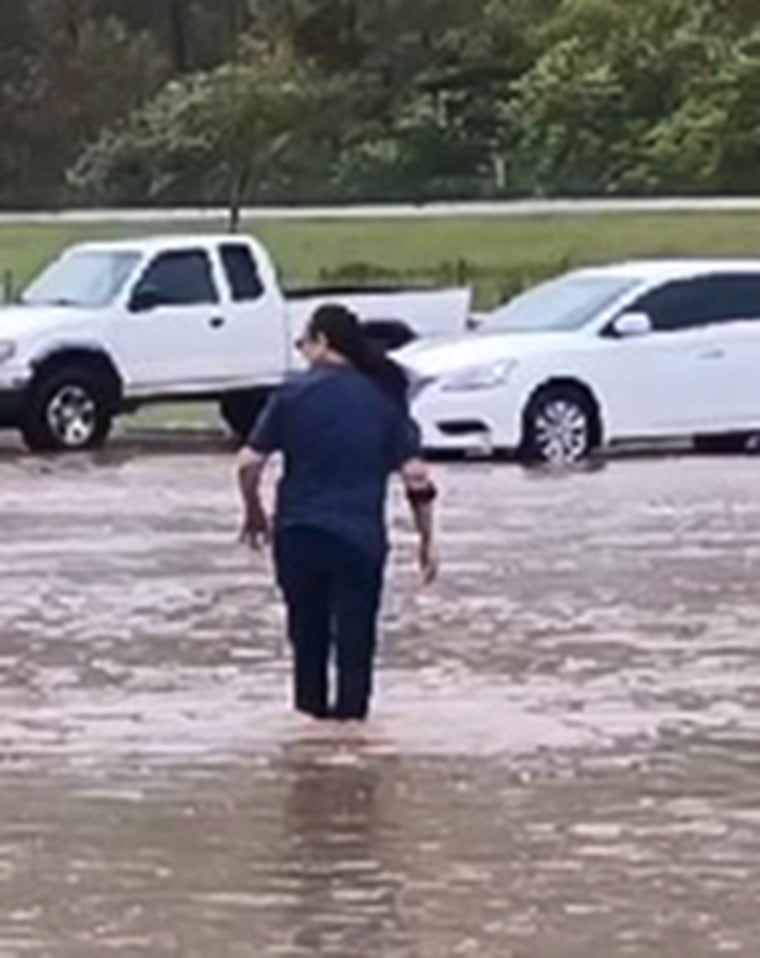 Zinnia Adkins took a picture of Bertha Mendoza walking across the parking lot before 11 a.m. Zinnia Adkins
Zinnia Adkins took a picture of Bertha Mendoza walking across the parking lot before 11 a.m. Zinnia Adkins10:50a.m.
By this time, all employees had been told to leave, with bilingual employees translating the announcement in Spanish, according to Impact Plastics’ preliminary review. At this point, water pooling in the parking lot was only about 6 inches deep and South Industrial Drive — the primary road into and out of the plant — “appears to have been passable,” the company stated.
Peterson’s daughter Alexa texted her father at 10:51 a.m. and asked if they would shut down for the day, and he responded, “they better,” according to a lawsuit filed by Peterson’s family.
After the power outage, some of the employees present migrated to the break room. “Power went out in the plant, and at that point, most of the time, whenever we have a power outage, everyone migrates to the break room,” said Fred Hudgins, an Impact Plastics employee for more than two decades. Once employees noticed water flooding into the parking lot, people started moving their cars to higher ground, Hudgins said. Impact Plastics owner Gerald O’Connor said, “Let’s just shut it down,” according to Hudgins.
10:56 a.m.
Hernandez-Corona, one of the victims, responded to a message from her sisters on WhatsApp asking if she was OK and if she had gone to work that day. “Sí. We are. Flooding,” Hernandez-Corona wrote in three brief messages shared with NBC News by a family member. “My God,” one of the sisters responds.
 One of Monica Hernandez-Corona's sisters texts her in Spanish asking if she went to work. Hernandez-Corona texts back, "Yes. We Are. Flooding. Her sister writes back, "My God." Obtained by NBC News
One of Monica Hernandez-Corona's sisters texts her in Spanish asking if she went to work. Hernandez-Corona texts back, "Yes. We Are. Flooding. Her sister writes back, "My God." Obtained by NBC News11 a.m.
Around this time, Dorsey, the truck driver, left Dura-line’s parking lot. He saw high water levels on the road and people still in the Impact Plastics parking lot, he said.
A woman, whom he was later told was Mendoza, knocked on the door of his truck, asking to get in to stay on higher ground. He said Mendoza and nine other people got into his truck and climbed aboard its trailer and started calling 911 and their loved ones.
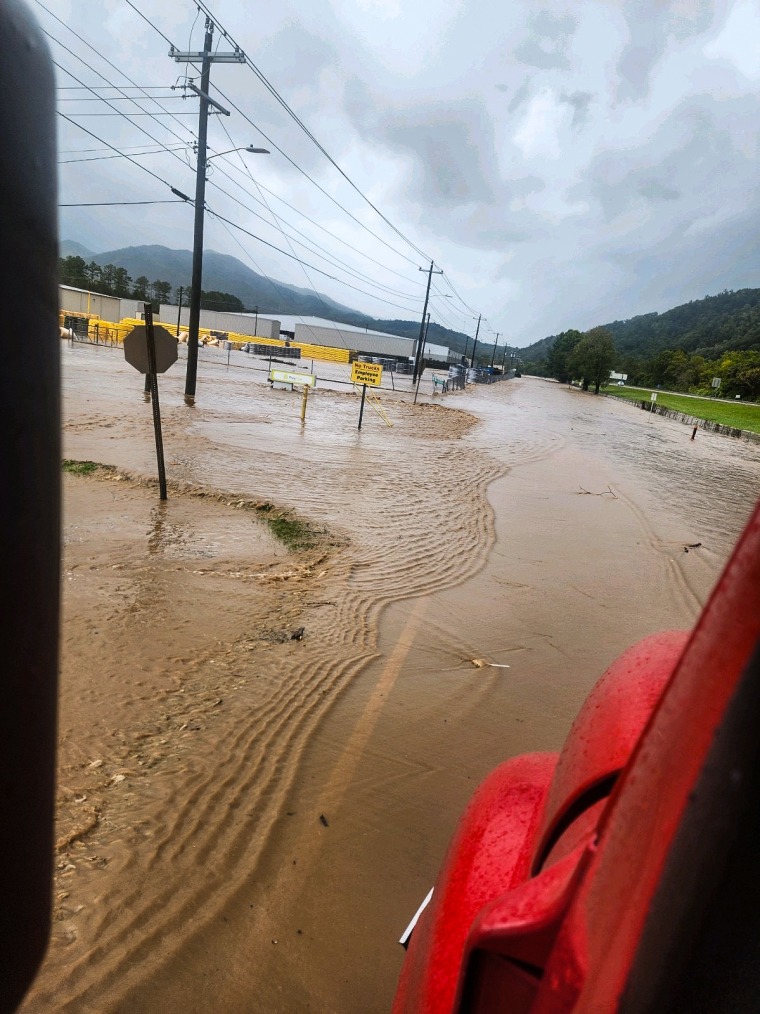 A view from Michael Dorsey's truck on the road next to Impact Plastics. Michael Dorsey
A view from Michael Dorsey's truck on the road next to Impact Plastics. Michael Dorsey11 a.m.-11:30 a.m.
Rangek and another colleague decided to leave Impact Plastics since she had not heard any news or instructions from management, she said. She returned to get belongings and sees water inside the plant. Water had also risen in the parking lot. A colleague with a pickup truck agrees to drive her home along with two others, she said.
Approximately 11:20 a.m.
Water started to fill the cab of Dorsey’s truck, forcing him and Mendoza to move to the attached trailer where other employees are perched. The truck eventually broke loose from the trailer.
11:23 a.m.
Peterson sent a photo to his daughter, Alexa, showing several inches of water inside Impact Plastics plant, according to WSMV in Nashville.
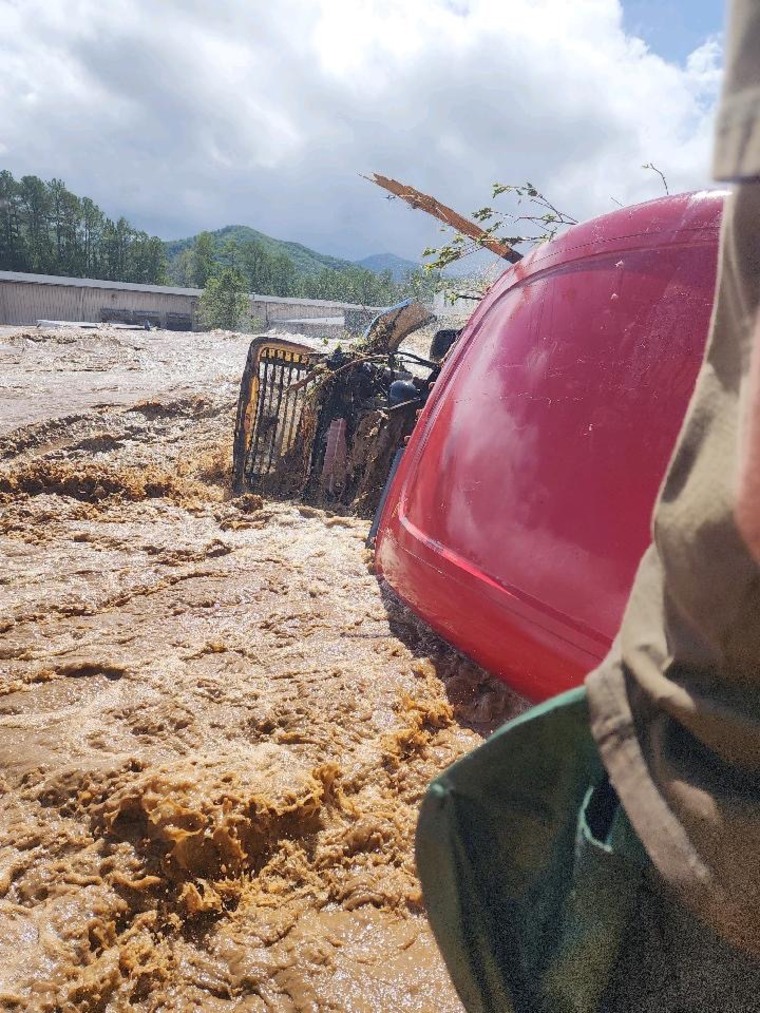 Michael Dorsey's truck capsizes.Michael Dorsey
Michael Dorsey's truck capsizes.Michael Dorsey11:30 a.m.-noon
A manager at Impact Plastics told employees they could go, Adkins said. “I’m scared of water because I can’t swim real well, so a guy that worked there helped me across the parking lot,” Adkins said.
“Water was up underneath my arms” when she left, she said. “The road [to Impact Plastics] is a one-way road. You can’t get in and in or out if it’s blocked off. So we’re stranded there … nowhere to go.” Adkins described walking toward the northeast end of the industrial park at this point, in the hopes that her husband could drive down the interstate and come pick her up.
11:35 a.m.
Senior management attempted to move the company server and important documents, finished a final walkthrough of the plant and left, according to Impact Plastics’ preliminary review. These were the last individuals to leave the building, the review stated.
Their walkthrough took less than 10 minutes, and at that point, no one else was in the building, Hudgins said. They had to “make the owner leave,” he said.
Peterson, one of the victims, guided Hudgins and three other employees, including the chief financial officer and O’Connor, the owner, out a side door of the building and toward railroad tracks behind Impact Plastics, Hudgins said. Peterson went around to the front of the building to see if there was a way out, and got separated from Hudgins and O’Connor, Hudgins said.
Sometime later, a van from Nuclear Fuel Services rescued the group on the tracks after one of them made a call to a friend at the company, Hudgins said.
“When we got in the van, we were still trying to contact rescue people … 'We still have people on the road. Can you please get somebody?’ We could see them from the railroad tracks,” he said. “And the water was just so high and rushing so rapidly that even an effort to try to get over to them, to lead them to where we were, was an impossibility.”
11:48 a.m.
The Erwin Police Department issued a state of emergency.
11:51 a.m.
A third NWS alert went out to cellphones across Erwin and other areas along the river, extending the flash flood emergency until 2 p.m.
12:08 p.m.
Mendoza sent her daughter Clarissa a video of flooding in the Impact Plastics parking lot. Clarissa offered to come meet her mother on the interstate, but Bertha told her that the water is rushing so rapidly that there is no way to get to the interstate, according to an attorney representing the Mendoza family.
12:32 p.m.
Hernandez-Corona sent a message to her sisters again on WhatsApp saying in Spanish: “I am okay. I am here on top of a trailer.”
12:48 p.m.
Hernandez-Corona sent a tearful audio message to her sisters, “Pray for us please” that was shared with NBC News by a family member.
12:52 p.m.
Hernandez-Corona sent another audio message to her sisters: “I’m here on a trailer but the water is about to get here. Please, God bless us. I don’t know what is going to happen. Take good care of my children.”
12:57 p.m.
Peterson sent a final video to his daughter of the turbulent waters surrounding him and other workers aboard Dorsey’s flatbed trailer, according to his daughter in an interview with WSMV in Nashville.
1 p.m.
Adkins called her husband for the last time before she meets up with him at the far side of the industrial park, according to her call logs. He used wire cutters to break through a barbed wire fence and then drove her home, she said.
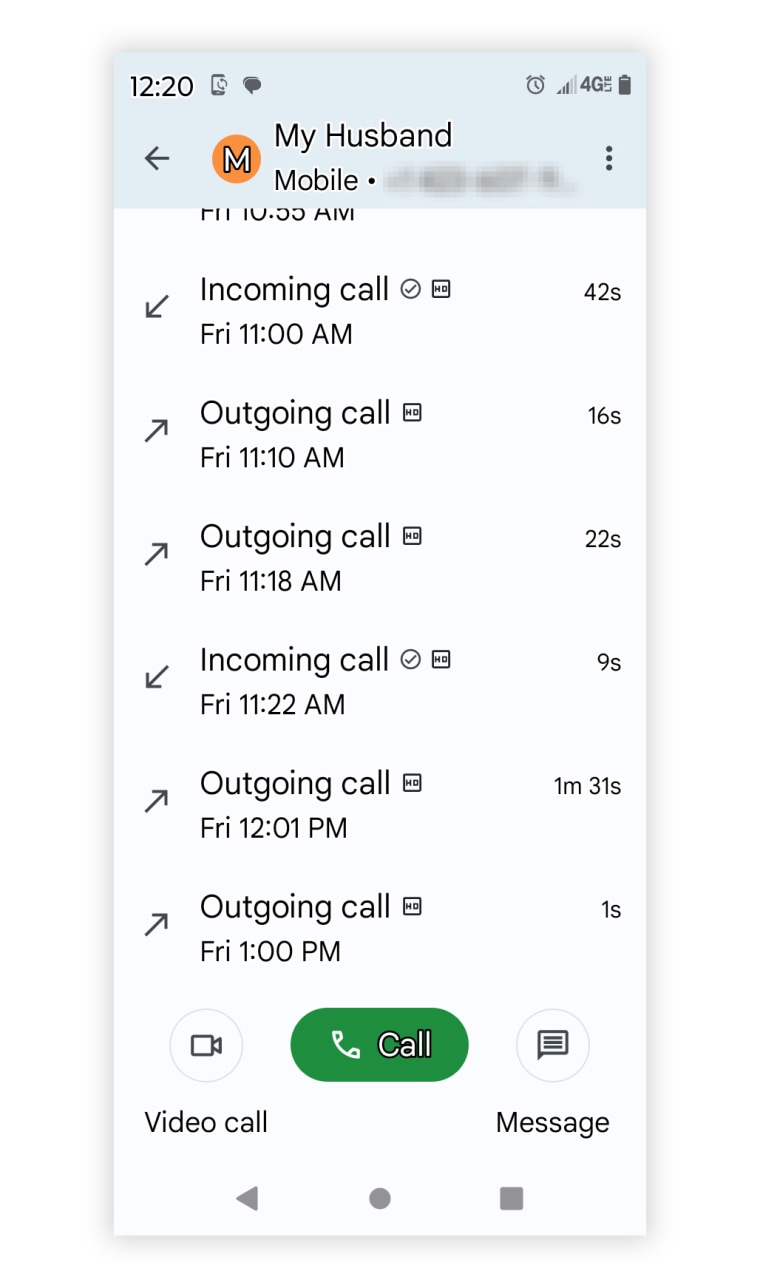 A screenshot of Zinnia Adkins' cell phone shows the calls she made to her husband, who was trying to rescue her.Zinnia Adkins
A screenshot of Zinnia Adkins' cell phone shows the calls she made to her husband, who was trying to rescue her.Zinnia Adkins1:03 p.m.
Hernandez-Corona sent a desperate audio message in Spanish to her sisters: “Care for us. Protect each of my children, Lord. We are atop a trailer.”
1:28 p.m.
In her last audio message to her sisters, Hernandez-Corona said: “I’m still praying, Lord.”
Mendoza started calling family members to say goodbye, according to the family’s attorney. She told her daughter Clarissa that she loved her and to keep the stranded group in her prayers. She told her son Emanuel that this would be the last phone call because she needed to hold onto something for safety and her phone would get wet.
1:49 p.m.
Another NWS alert went out to cellphones at or near the plant, extending the flash flood emergency until 5 p.m.
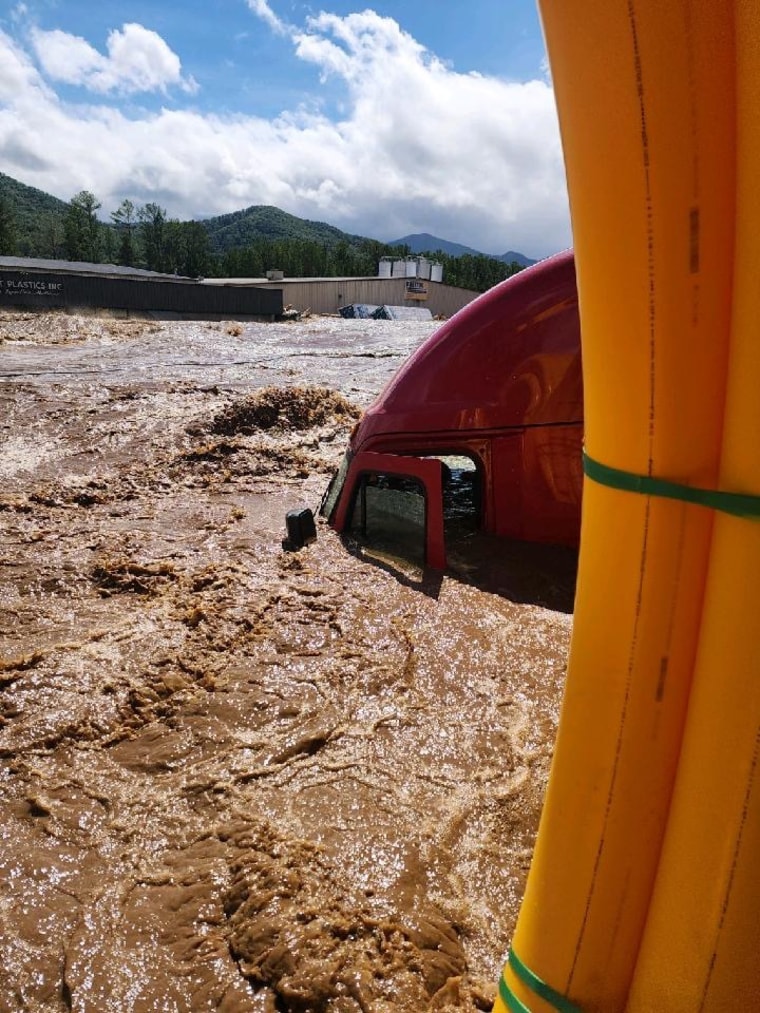 Water fills the cab of Michael Dorsey's truck.Michael Dorsey
Water fills the cab of Michael Dorsey's truck.Michael DorseyTime unknown
On the trailer and amid strong currents, “we hit a tree or something. We hit a tree, my trailer capsized, and everybody fell off the trailer,” Dorsey said in an interview with NBC News.
“And once we got inside of the water, I was trying to hold on to Ms. Bertha, but I got hit upside the head by something, and I got knocked unconscious,” Dorsey said. “When I came back to, I was looking for something to grab onto. … I ended up grabbing ahold to one of the tube things that fell off my truck.”
4-5 p.m.
Dorsey and the others who were able to grab onto the plastic pipes from his trailer float in the floodwaters until they wash up in a pile of debris pushed against trees and are able to stand, Dorsey said.
Sometime later, a National Guard helicopter rescued Dorsey and seven other people, he said. A fan boat had tried to reach them but the current was too strong, Dorsey said.
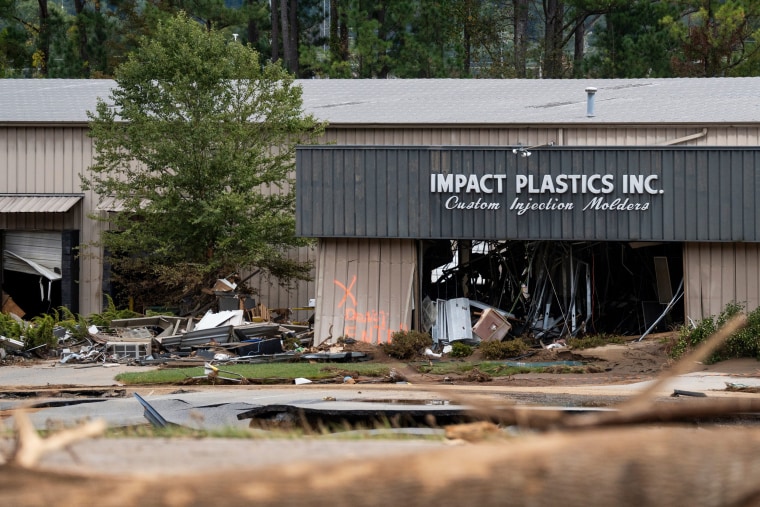 Impact Plastics, surrounded by mud and debris, on Oct. 1.Brianna Paciorka / News Sentinel / USA Today Network file
Impact Plastics, surrounded by mud and debris, on Oct. 1.Brianna Paciorka / News Sentinel / USA Today Network fileWeek of Sept. 30
In an interview with NBC News four days later, Jarvis said of his lost co-workers: “The hardest part is knowing I’m here and they’re not. They should be here with me.”
Adkins and Jarvis survived the ordeal, but they say they can’t sleep. Dorsey, still in pain from the injuries he sustained that day, said that “mentally, I’m still messed up … that lady died,” referring to Mendoza.
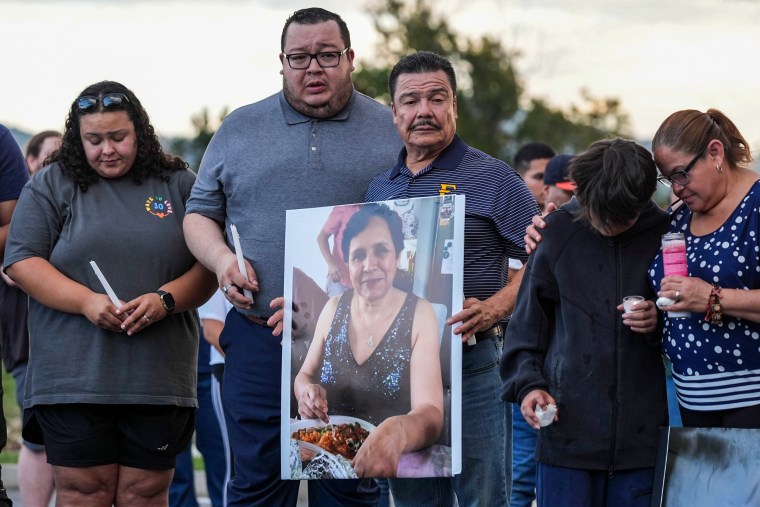 The family of Bertha Mendoza carries her portrait at a candlelight vigil on Oct. 3 for the victims of the floods in Erwin, Tenn.Saul Young / News Sentinel / USA Today Network via Reuters file
The family of Bertha Mendoza carries her portrait at a candlelight vigil on Oct. 3 for the victims of the floods in Erwin, Tenn.Saul Young / News Sentinel / USA Today Network via Reuters fileMonday, Oct. 7
Preparing for Mendoza’s funeral, her husband Elías, accompanied by one of his sons, Guillermo, described how he had moved between the U.S. and Mexico as a guest worker for years, until he was able to get visas so he, his wife and their children could live permanently in the U.S. He would tell her that even if their children left to marry and live their own lives, “what I love the most is that I still have you.”
Since that Friday, Sept. 27, “the most difficult thing is to have to understand that she is not there,” said her husband of 38 years, “to cross that door and to understand that she’s no longer there.”
.png)
 5 hours ago
12
5 hours ago
12
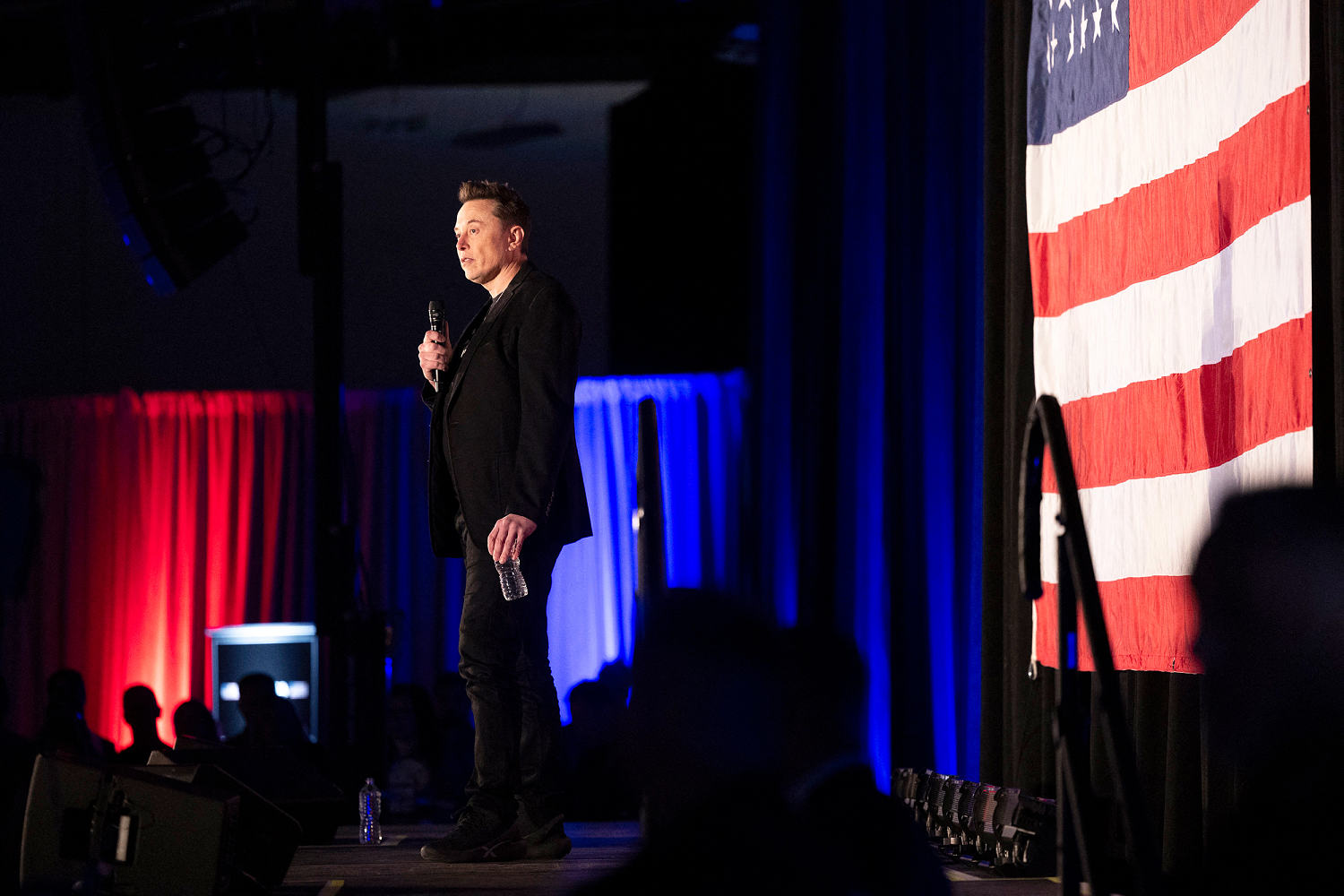























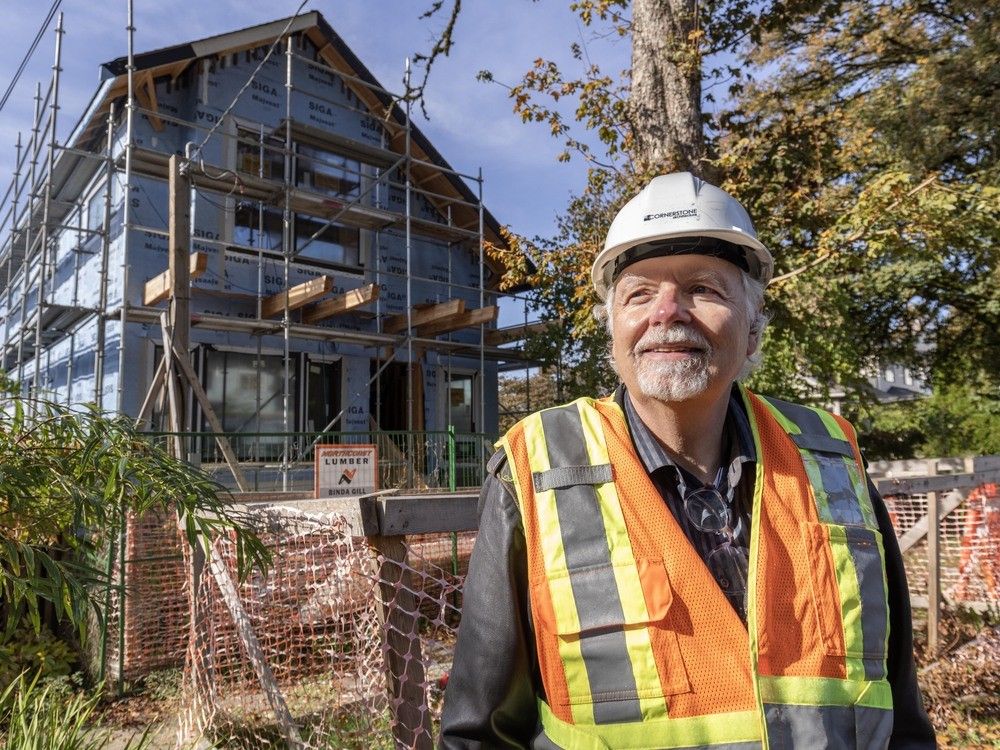




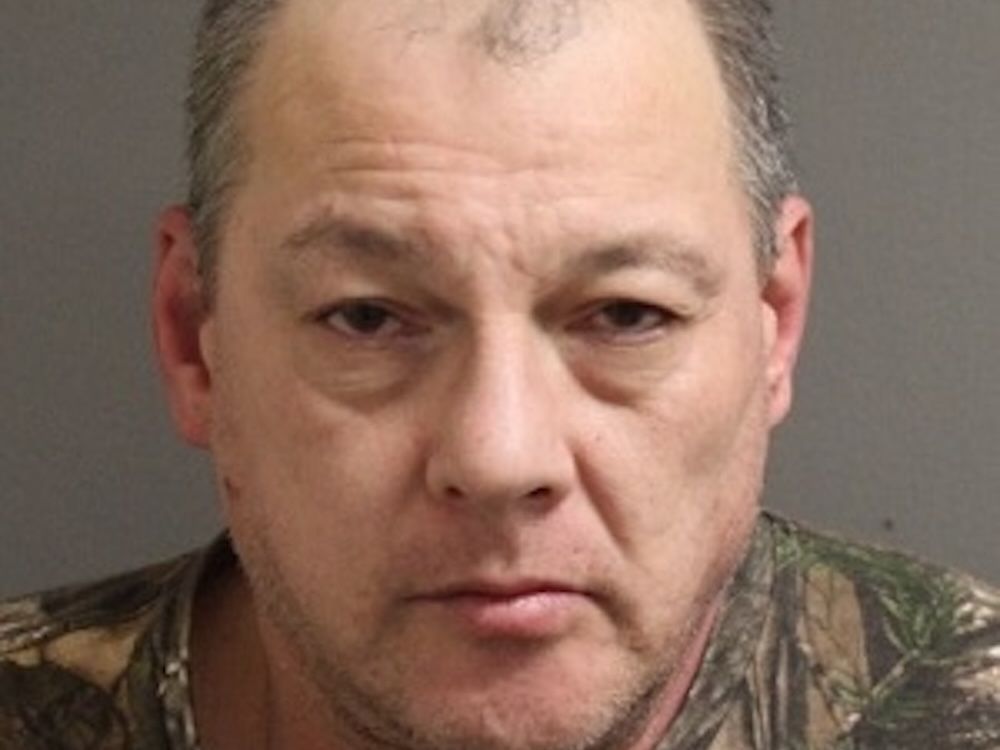

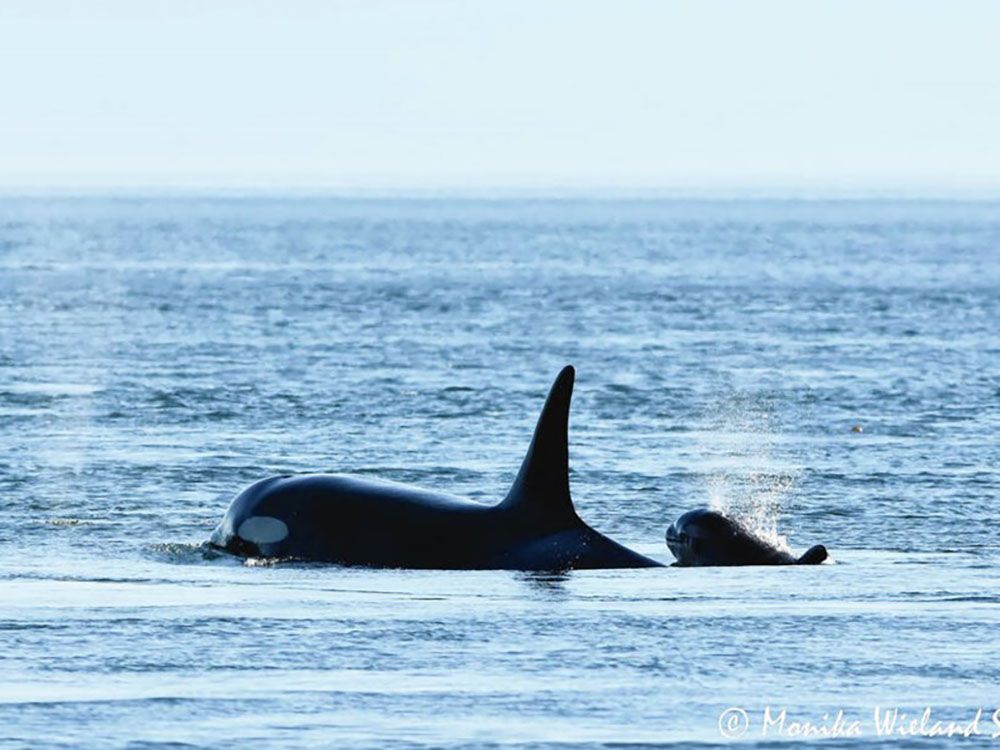


 Bengali (BD) ·
Bengali (BD) ·  English (US) ·
English (US) ·